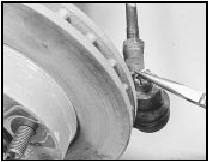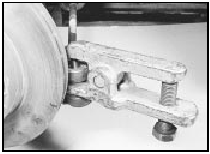Tie-rod end - removal and refitting
Note: A balljoint separator tool will be required for this operation.
Removal
1 Loosen the relevant front roadwheel nuts,
apply the handbrake, jack up the front of the
vehicle and support on axle stands.
2 Remove the roadwheel. On P100 models mark the position of the roadwheel in relation to one of the wheel studs before removal.
3 Make alignment marks on the tie-rod and tie-rod end, then loosen the locknut by a quarter of a turn.
4 Extract the split pin and unscrew the castellated nut (see illustration).

33.4 Extracting the split pin from the tierod balljoint castellated nut
5 Using a balljoint separator tool, release the tie-rod end from the hub carrier (see illustration).

33.5 Using a balljoint separator tool to release the tie-rod end from the hub
carrier
6 Unscrew the tie-rod end from the tie-rod, noting the number of turns necessary to remove it.
Refitting
7 Refitting is a reversal of removal, bearing in
mind the following points.
8 Screw the tie-rod end onto the tie-rod the number of turns noted during removal.
9 Tighten the nuts to the specified torque, and fit a new split pin to the castellated nut.
10 On P100 models, align the previously made marks on the roadwheel and wheel stud.
11 On completion, check and if necessary adjust the front wheel alignment.
See also:
EEC IV module - removal and refitting
Removal
1 The EEC IV module is located behind the
centre console, beneath the trim panel (see
illustration).
20.1 EEC IV module location (arrowed) 1.4 CFI engine
2 Disconnect the battery negati ...
Carburettor (Pierburg 2V type) - fast idle speed adjustment
1 Check the idle speed and mixture
adjustment. The idle speed must be correct
before attempting to check or adjust the fast
idle speed.
2 With the engine at normal operating
temperature, and a ta ...
Fuel tank - removal and refitting
Note: Refer to the warning at the end of
Section 1 before proceeding.
Removal
1 The fuel tank will normally only need to be
removed if it is severely contaminated with
sediment or other substance ...
